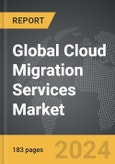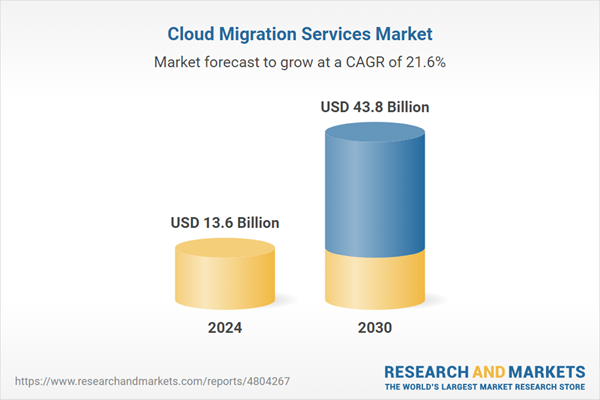Global Cloud Migration Services Market - Key Trends and Drivers Summarized
What Are Cloud Migration Services, and How Do They Work?
Cloud Migration Services involve the process of moving an organization's digital assets, services, databases, applications, and IT resources from on-premise or legacy infrastructure to the cloud. This transition can take place across different types of cloud environments, including public, private, or hybrid clouds. The services typically cover a range of tasks, from assessment and planning, where cloud migration specialists evaluate the existing infrastructure, to execution, which includes rehosting, refactoring, or even rebuilding applications to optimize them for the cloud. These services also encompass data migration, network configuration, security enhancements, and post-migration testing and optimization to ensure that the migration meets the organization's performance, security, and cost objectives. By leveraging automation tools, cloud migration services can streamline the process, minimize downtime, and reduce the risk of data loss or system failures during the transition. Providers of these services often employ best practices to ensure seamless integration and interoperability between cloud systems and the existing IT environment, allowing businesses to migrate with minimal disruption to operations.Why Are Cloud Migration Services Vital for Modern Enterprises?
In an increasingly cloud-centric world, cloud migration services have become essential for businesses looking to modernize their IT infrastructure and stay competitive. Many enterprises, particularly those with legacy systems, are finding it difficult to keep pace with the demands of digital transformation without transitioning to more flexible and scalable cloud platforms. Cloud migration services provide the expertise and tools necessary to execute this transition efficiently, allowing businesses to tap into the cloud's vast potential without the risks that come with an unmanaged migration. One of the primary drivers behind cloud migration is the need for scalability. As businesses grow and their data and application needs expand, on-premise systems often struggle to accommodate this growth, leading to performance bottlenecks and high costs for additional hardware. Cloud platforms, by contrast, offer virtually limitless scalability, enabling businesses to scale their operations seamlessly in response to demand. Additionally, cloud migration services help organizations improve their disaster recovery capabilities. Traditional data recovery solutions are often costly and slow, but cloud-based systems provide rapid recovery and high availability, reducing the risk of extended downtime in the event of an outage. For businesses aiming to enhance agility, reduce IT costs, and future-proof their operations, cloud migration services are becoming indispensable.How Are Emerging Technologies Enhancing Cloud Migration Services?
The evolution of cloud migration services is being driven by several emerging technologies that are making the migration process faster, safer, and more efficient. Automation plays a central role in simplifying complex migration processes. Tools that automate the migration of databases, applications, and workloads can significantly reduce the time required for the transition and eliminate many of the manual tasks that can introduce errors. These tools also help ensure that data integrity is maintained throughout the migration process, minimizing the risk of loss or corruption. Artificial Intelligence (AI) and Machine Learning (ML) are also influencing cloud migration by offering predictive analytics that help businesses plan and optimize their migration strategy. For instance, AI-driven tools can analyze an organization's existing infrastructure and suggest the best cloud deployment models, configurations, and migration paths, thereby reducing costs and improving efficiency. Additionally, containerization and microservices are allowing businesses to migrate applications more flexibly. Instead of moving entire applications at once, containerized applications can be broken down into smaller components, which can be migrated and scaled independently. This granular approach reduces the complexity of migrating large, monolithic applications to the cloud, making the process smoother and more manageable. Moreover, multi-cloud strategies are becoming increasingly popular, and cloud migration services are evolving to support the movement of data and applications across multiple cloud environments, ensuring compatibility and integration between different cloud platforms.What Factors Are Driving the Growth of Cloud Migration Services?
The growth in the cloud migration services market is driven by several key factors, each reflecting the ongoing shift toward cloud-first strategies and the increasing demand for digital transformation. First and foremost is the sheer volume of data being generated by businesses today. Legacy IT systems often struggle to handle this data efficiently, pushing companies to migrate to the cloud, where they can take advantage of scalable storage and processing power. The rise of hybrid and multi-cloud strategies is another major driver. Many businesses are opting for hybrid cloud setups that combine the flexibility of the public cloud with the security of private cloud solutions, or they may choose a multi-cloud strategy to avoid vendor lock-in and leverage the best features of different cloud platforms. Cloud migration services are essential in facilitating these complex transitions, ensuring that data and applications can move seamlessly between on-premise systems and multiple cloud environments. Furthermore, regulatory compliance is playing an increasingly important role in cloud migration decisions. Regulations such as GDPR, HIPAA, and CCPA require businesses to adhere to strict data protection and privacy standards, and cloud providers often offer advanced compliance tools that are difficult to replicate with on-premise systems. Lastly, cost optimization is a significant growth driver. Businesses are continually seeking ways to reduce their IT expenditures, and cloud migration services offer a path to more efficient resource usage. By moving to the cloud, organizations can shift from capital expenditure (CapEx) models, where they invest heavily in physical hardware, to operating expenditure (OpEx) models, where they pay only for the resources they use, leading to more predictable and manageable costs. As more companies embrace these trends, the demand for cloud migration services is expected to continue rising, making them a crucial element of the digital transformation journey.Report Scope
The report analyzes the Cloud Migration Services market, presented in terms of market value (USD). The analysis covers the key segments and geographic regions outlined below.- Segments: Deployment (Public Deployment, Private Deployment, Hybrid Deployment); End-Use (IT & Telecom End-Use, BFSI End-Use, Healthcare End-Use, Government & Public Sector End-Use, Automotive End-Use, Manufacturing End-Use, Other End-Uses).
- Geographic Regions/Countries: World; United States; Canada; Japan; China; Europe (France; Germany; Italy; United Kingdom; and Rest of Europe); Asia-Pacific; Rest of World.
Key Insights:
- Market Growth: Understand the significant growth trajectory of the IT & Telecom End-Use segment, which is expected to reach US$13 Billion by 2030 with a CAGR of 23.9%. The BFSI End-Use segment is also set to grow at 22.5% CAGR over the analysis period.
- Regional Analysis: Gain insights into the U.S. market, valued at $3.6 Billion in 2024, and China, forecasted to grow at an impressive 20.3% CAGR to reach $6.6 Billion by 2030. Discover growth trends in other key regions, including Japan, Canada, Germany, and the Asia-Pacific.
Why You Should Buy This Report:
- Detailed Market Analysis: Access a thorough analysis of the Global Cloud Migration Services Market, covering all major geographic regions and market segments.
- Competitive Insights: Get an overview of the competitive landscape, including the market presence of major players across different geographies.
- Future Trends and Drivers: Understand the key trends and drivers shaping the future of the Global Cloud Migration Services Market.
- Actionable Insights: Benefit from actionable insights that can help you identify new revenue opportunities and make strategic business decisions.
Key Questions Answered:
- How is the Global Cloud Migration Services Market expected to evolve by 2030?
- What are the main drivers and restraints affecting the market?
- Which market segments will grow the most over the forecast period?
- How will market shares for different regions and segments change by 2030?
- Who are the leading players in the market, and what are their prospects?
Report Features:
- Comprehensive Market Data: Independent analysis of annual sales and market forecasts in US$ Million from 2024 to 2030.
- In-Depth Regional Analysis: Detailed insights into key markets, including the U.S., China, Japan, Canada, Europe, Asia-Pacific, Latin America, Middle East, and Africa.
- Company Profiles: Coverage of players such as Amazon Web Services, Inc., Cisco Systems, Inc., DXC Technology Company, Google, Inc., IBM Corporation and more.
- Complimentary Updates: Receive free report updates for one year to keep you informed of the latest market developments.
Some of the 24 companies featured in this Cloud Migration Services market report include:
- Amazon Web Services, Inc.
- Cisco Systems, Inc.
- DXC Technology Company
- Google, Inc.
- IBM Corporation
- Informatica LLC
- Microsoft Corporation
- NTT DATA Corporation
- Openstack
- Rackspace US, Inc.
- RiverMeadow Software, Inc.
- Virtustream, Inc.
- Vmware, Inc.
- WSM International
- Zerto Inc.
This edition integrates the latest global trade and economic shifts into comprehensive market analysis. Key updates include:
- Tariff and Trade Impact: Insights into global tariff negotiations across 180+ countries, with analysis of supply chain turbulence, sourcing disruptions, and geographic realignment. Special focus on 2025 as a pivotal year for trade tensions, including updated perspectives on the Trump-era tariffs.
- Adjusted Forecasts and Analytics: Revised global and regional market forecasts through 2030, incorporating tariff effects, economic uncertainty, and structural changes in globalization. Includes historical analysis from 2015 to 2023.
- Strategic Market Dynamics: Evaluation of revised market prospects, regional outlooks, and key economic indicators such as population and urbanization trends.
- Innovation & Technology Trends: Latest developments in product and process innovation, emerging technologies, and key industry drivers shaping the competitive landscape.
- Competitive Intelligence: Updated global market share estimates for 2025, competitive positioning of major players (Strong/Active/Niche/Trivial), and refined focus on leading global brands and core players.
- Expert Insight & Commentary: Strategic analysis from economists, trade experts, and domain specialists to contextualize market shifts and identify emerging opportunities.
Table of Contents
Companies Mentioned (Partial List)
A selection of companies mentioned in this report includes, but is not limited to:
- Amazon Web Services, Inc.
- Cisco Systems, Inc.
- DXC Technology Company
- Google, Inc.
- IBM Corporation
- Informatica LLC
- Microsoft Corporation
- NTT DATA Corporation
- Openstack
- Rackspace US, Inc.
- RiverMeadow Software, Inc.
- Virtustream, Inc.
- Vmware, Inc.
- WSM International
- Zerto Inc.
Table Information
| Report Attribute | Details |
|---|---|
| No. of Pages | 183 |
| Published | December 2025 |
| Forecast Period | 2024 - 2030 |
| Estimated Market Value ( USD | $ 13.6 Billion |
| Forecasted Market Value ( USD | $ 43.8 Billion |
| Compound Annual Growth Rate | 21.6% |
| Regions Covered | Global |









